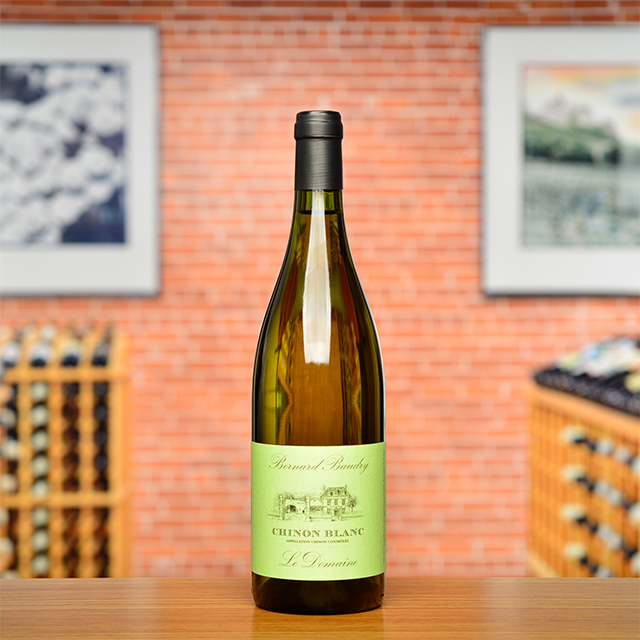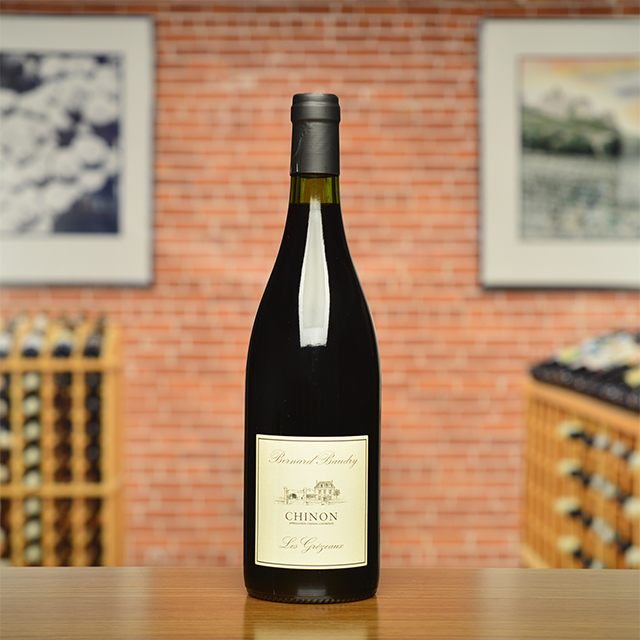Notify me
2019 Chinon
Bernard Baudry
One producer who is largely responsible for Chinon’s notoriety is Bernard Baudry, and his son Matthieu, who now manages the domaine. The Baudrys farm vineyards scattered across Chinon, from parcels that sit on clay-and-limestone slopes to those nestled along a gravel-and-sand riverbank. They accordingly produce many unique styles of wine even though they all fall within the appellation of Chinon. This cuvée comes from their highest vineyard, which rests on a plateau of gravel, sand, and limestone, and it is arguably their best entry point into the charm of Loire Valley Cabernet Franc, lithe and less dense than the bottlings from their clay-and-limestone terroirs. Spontaneous fermentation and unfiltered bottling lead to a delicate, peppery wine with notes of blackberries, currants, and leather. Matthieu Baudry says the reds of Chinon are best enjoyed with food, and this particular bottling is versatile enough to accompany a wide range of plats, from lentil soup to charcuterie to roast chicken.
—Tom Wolf
| Wine Type: | red |
| Vintage: | 2019 |
| Bottle Size: | 750mL |
| Blend: | Cabernet Franc |
| Appellation: | Chinon |
| Country: | France |
| Region: | Loire |
| Producer: | Bernard Baudry |
| Winemaker: | Matthieu & Bernard Baudry |
| Vineyard: | 30 years |
| Soil: | Gravel, Clay, Silica |
| Aging: | Aged in cement and wood cuves for respectively nine and twelve months |
| Farming: | Organic (practicing) |
| Alcohol: | 13% |
More from this Producer or Region

2020 Muscadet Sèvre et Maine Clisson “La Molette”
France | Loire
A subtly floral nose and textured mouthfeel seal the deal. This is off-the-charts Muscadet.

2022 Vin de France Rouge “Le Martray”
France | Loire
The new vintage shows great freshness and brightness, making me think of tart berries picked in the forest just a touch below full ripeness.

2023 Chinon Blanc
France | Loire
A rare Chenin Blanc from the land of Cabernet Franc. Ultra fresh and brimming with citrus blossom and orchard fruit notes, it has a saline, mineral finish that leaves my palate simultaneously satisfied and begging for more. Try it with fresh trout, grilled whole topped with chimichurri or smoked and tossed into a Niçoise salad.

2022 Chinon “Le Domaine”
France | Loire
It is fresh and buoyant enough for casual fare yet has the stuffing to accompany heartier dishes, while its vivid raspberry fruit makes it extremely approachable today, notwithstanding its medium-term aging potential.

2021 Chinon “La Croix Boissée”
France | Loire
This is the grandest bottling of Cabernet Franc from one of Chinon’s most outstanding producers.

2024 Chinon Rosé
France | Loire
Matthieu Baudry captures both youthful fruit and energizing mineral textures with this rosé.

2023 Chinon “Les Grézeaux”
France | Loire
Les Grézeaux comes from the Baudry’s oldest vines, which yield a concentrated and silky rouge that is ready to drink today but will age beautifully.

2021 Bourgueil “Clos Sénéchal”
France | Loire
This divine red allies the power and finesse one would expect from this great terroir.

2024 Saumur Blanc “L’Insolite”
France | Loire
Made from nearly hundred-year-old vines, this a great initiation into the world of Thierry’s white wines.

2021 Chinon “Le Clos Guillot”
France | Loire
October Club Rouge ~ Even though all of the wines hail from Chinon, the soil, elevation, and exposition all combine to make Le Clos Guillot their cuvée with the most finesse.
About The Producer
Bernard Baudry
About The Region
Loire

The defining feature of the Loire Valley, not surprisingly, is the Loire River. As the longest river in France, spanning more than 600 miles, this river connects seemingly disparate wine regions. Why else would Sancerre, with its Kimmeridgian limestone terroir be connected to Muscadet, an appellation that is 250 miles away?
Secondary in relevance to the historical, climatic, environmental, and cultural importance of the river are the wines and châteaux of the Jardin de la France. The kings and nobility of France built many hundreds of châteaux in the Loire but wine preceded the arrival of the noblesse and has since out-lived them as well.
Diversity abounds in the Loire. The aforementioned Kimmeridgian limestone of Sancerre is also found in Chablis. Chinon, Bourgueil, and Saumur boast the presence of tuffeau, a type of limestone unique to the Loire that has a yellowish tinge and a chalky texture. Savennières has schist, while Muscadet has volcanic, granite, and serpentinite based soils. In addition to geologic diversity, many, grape varieties are grown there too: Cabernet Franc, Chenin Blanc, Sauvignon Blanc, and Melon de Bourgogne are most prevalent, but (to name a few) Pinot Gris, Grolleau, Pinot Noir, Pineau d’Aunis, and Folle Blanche are also planted. These myriad of viticultural influences leads to the high quality production of every type of wine: red, white, rosé, sparkling, and dessert.
Like the Rhône and Provence, some of Kermit’s first imports came from the Loire, most notably the wines of Charles Joguet and Château d’Epiré—two producers who are featured in Kermit’s book Adventures on the Wine Route and with whom we still work today.
More from Loire or France
2022 Jasnières “Dyane”
Christine de Mianville France | Loire
2024 Saumur Champigny “Cuvée Domaine”
Thierry Germain France | Loire
2023 Saumur Mousseux “Bulles de Roche”
Thierry Germain France | Loire
2022 Vin de France Rouge “Le Martray”
Grange Saint Sauveur France | Loire
2024 Saumur Blanc “L’Insolite”
Thierry Germain France | Loire
2021 Chinon “La Croix Boissée”
Bernard Baudry France | Loire
2024 Sancerre
Daniel Chotard France | Loire
2021 Saumur-Champigny “Les Mémoires”
Thierry Germain France | Loire
2024 Val de Loire Rouge Grolleau
Catherine & Pierre Breton France | Loire
2020 Vin de France Blanche
Domaine Michel Brégeon France | Loire
2020 Vin de France Rouge Cabernet Franc “Huguette”
Grange Saint Sauveur France | Loire
2024 Cheverny
Domaine du Salvard France | Loire
2022 Jasnières “Dyane”
Christine de Mianville France | Loire
2024 Saumur Champigny “Cuvée Domaine”
Thierry Germain France | Loire
2023 Saumur Mousseux “Bulles de Roche”
Thierry Germain France | Loire
2022 Vin de France Rouge “Le Martray”
Grange Saint Sauveur France | Loire
2024 Saumur Blanc “L’Insolite”
Thierry Germain France | Loire
2021 Chinon “La Croix Boissée”
Bernard Baudry France | Loire
2024 Sancerre
Daniel Chotard France | Loire
2021 Saumur-Champigny “Les Mémoires”
Thierry Germain France | Loire
2024 Val de Loire Rouge Grolleau
Catherine & Pierre Breton France | Loire
2020 Vin de France Blanche
Domaine Michel Brégeon France | Loire
2020 Vin de France Rouge Cabernet Franc “Huguette”
Grange Saint Sauveur France | Loire
2024 Cheverny
Domaine du Salvard France | Loire
Kermit once said...

Kermit once said...
For the wines that I buy I insist that the winemaker leave them whole, intact. I go into the cellars now and select specific barrels or cuvées, and I request that they be bottled without stripping them with filters or other devices. This means that many of our wines will arrive with a smudge of sediment and will throw a more important deposit as time goes by, It also means the wine will taste better.
















